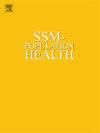Community-based social assistance programs and household food insecurity among de novo food-aid seekers in Quebec, Canada
IF 3.1
2区 医学
Q1 PUBLIC, ENVIRONMENTAL & OCCUPATIONAL HEALTH
引用次数: 0
Abstract
Objective
To examine the association between the use of community-based social assistance programs (CB-SAPs) and the reduction of household food insecurity among de novo food-aid seekers in Quebec, Canada.
Study design
Prospective Cohort Study.
Methods
A longitudinal observational study was conducted using a sample of 915 newly registered food-aid seekers in Quebec's food banks from The Pathways cohort study (2018–2020). The outcome was any reduction in the severity of Household Food Insecurity. Exposures included three CB-SAPS:1) using food donations, 2) using food-management related CB-SAPs (other than food donations), and 3) using CB-SAPs unrelated to food. We used Longitudinal Targeted Maximum Likelihood Estimation (LTMLE) to estimate the Relative Risk (RR) and LTMLE for working Marginal Structural Models to estimate Average Additive Treatment Effects (ATE) of the relationship between the use of CB-SAPs and Household Food Insecurity.
Results
The use of CB-SAPs showed a trend towards reduction of Household Food Insecurity. Compared to households using exclusively food banks at baseline, households with multiple-food-acquisition (Multiple AFS) health-promoting practices were more likely to reduce (in the relative scale) Household Food Insecurity by using: food donations (RR: 1.30; 95 %CI:1.01, 1.60); food-management related CB-SAPs (RR: 1.28; 95 %CI:1.03, 1.58); and CB-SAPs unrelated to food (RR: 1.33; 95 %CI:1.03, 1.62). Multiple AFS showed a reduction in the Household Food Insecurity (absolute) scale, especially among food-management related CB-SAPs users (ATE: −0.24; 95 %CI: 0.43, −0.04).
Conclusions
CB-SAPs use contributes to reducing Household Food Insecurity. This contribution varies depending on the food-acquisition health-promoting practices of food-aid seeker households.
加拿大魁北克省,以社区为基础的社会援助计划和家庭粮食不安全问题
目的研究加拿大魁北克省新寻求粮食援助的人使用社区社会援助计划(CB-SAPs)与减少家庭粮食不安全之间的关系。研究设计前瞻性队列研究。方法对魁北克食品银行915名新登记的食品援助寻求者进行纵向观察研究,样本来自Pathways队列研究(2018-2020)。结果是家庭粮食不安全的严重程度有所减轻。暴露包括三种CB-SAPS:1)使用食品捐赠,2)使用与食品管理相关的CB-SAPS(食品捐赠除外),以及3)使用与食品无关的CB-SAPS。我们使用纵向目标最大似然估计(LTMLE)来估计相对风险(RR),并使用LTMLE进行边际结构模型来估计cb - sap使用与家庭粮食不安全之间关系的平均加性处理效应(ATE)。结果cb - sap的使用呈现出减少家庭粮食不安全的趋势。与仅在基线时使用食物银行的家庭相比,采用多种食物获取(Multiple AFS)健康促进做法的家庭更有可能(在相对规模上)通过以下方式减少家庭粮食不安全:食物捐赠(相对危险度:1.30;95%可信区间:1.01,1.60);与食品管理相关的cb - sap (RR: 1.28; 95% CI:1.03, 1.58);与食物无关的cb - sap (RR: 1.33; 95% CI:1.03, 1.62)。多个AFS显示家庭粮食不安全(绝对)规模减少,特别是在与食品管理相关的cb - sap用户中(ATE: - 0.24; 95% CI: 0.43, - 0.04)。结论scb - saps的使用有助于减少家庭粮食不安全。这一贡献因寻求粮食援助的家庭获取粮食的促进健康做法而异。
本文章由计算机程序翻译,如有差异,请以英文原文为准。
求助全文
约1分钟内获得全文
求助全文
来源期刊

Ssm-Population Health
PUBLIC, ENVIRONMENTAL & OCCUPATIONAL HEALTH-
CiteScore
6.50
自引率
2.10%
发文量
298
审稿时长
101 days
期刊介绍:
SSM - Population Health. The new online only, open access, peer reviewed journal in all areas relating Social Science research to population health. SSM - Population Health shares the same Editors-in Chief and general approach to manuscripts as its sister journal, Social Science & Medicine. The journal takes a broad approach to the field especially welcoming interdisciplinary papers from across the Social Sciences and allied areas. SSM - Population Health offers an alternative outlet for work which might not be considered, or is classed as ''out of scope'' elsewhere, and prioritizes fast peer review and publication to the benefit of authors and readers. The journal welcomes all types of paper from traditional primary research articles, replication studies, short communications, methodological studies, instrument validation, opinion pieces, literature reviews, etc. SSM - Population Health also offers the opportunity to publish special issues or sections to reflect current interest and research in topical or developing areas. The journal fully supports authors wanting to present their research in an innovative fashion though the use of multimedia formats.
 求助内容:
求助内容: 应助结果提醒方式:
应助结果提醒方式:


